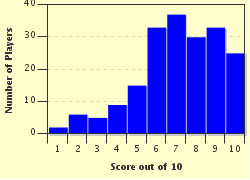Quiz Answer Key and Fun Facts
1. Jane Austen (1775-1817) wrote novels like "Pride and Prejudice" (1813) about the English countryside, lightly ironic yet with serious underpinnings that have made them popular for centuries. Which is not among her works?
2. Charles Dickens (1812-1870) was a prolific writer. Many of his works, like "Oliver Twist", take the name of the protagonist as their title. But one of these was written by someone OTHER than Dickens -- which one?
3. Russian author Fyodor Dostoyevsky (1821-1881) wrote novels that delved into the darkest depths of the human heart. Which of these is NOT among his influential novels of the 19th century?
4. Willa Cather (1873-1947) wrote about the settlement of the American West, particularly Nebraska. Which of these is not among her works?
5. Dame Agatha Christie (1890-1976) was, is, and ever shall be the queen of the mystery genre. Which of these books is NOT among the late, great author's works?
6. F. Scott Fitzgerald (1896-1940) was a member of the "Lost Generation" who grew up in New York, the setting of his novels. Which of these was written by a Southerner instead?
7. Ray Bradbury (1920-2012) was one of America's best-known science fiction writers. Which of these books was NOT one of his?
8. Toni Morrison (1931-2019) wrote several novels centering on African-American women that many critics have called postmodern feminist, although she rejected that characterization. Which is NOT one of her books?
9. The novels of Chilean-American author Isabel Allende (b. 1942) fall in the magic realist genre, which means fantastical elements play a natural part in an otherwise real-world environment. Which of these, however, was written by a different hispanophonic author? (Spanish title in parentheses.)
10. John Grisham (b. 1955) wrote several suspense novels, many of which were adapted into movies. Which of these, however, is NOT among those legal thrillers?
Source: Author
gracious1
This quiz was reviewed by FunTrivia editor
agony before going online.
Any errors found in FunTrivia content are routinely corrected through our feedback system.


